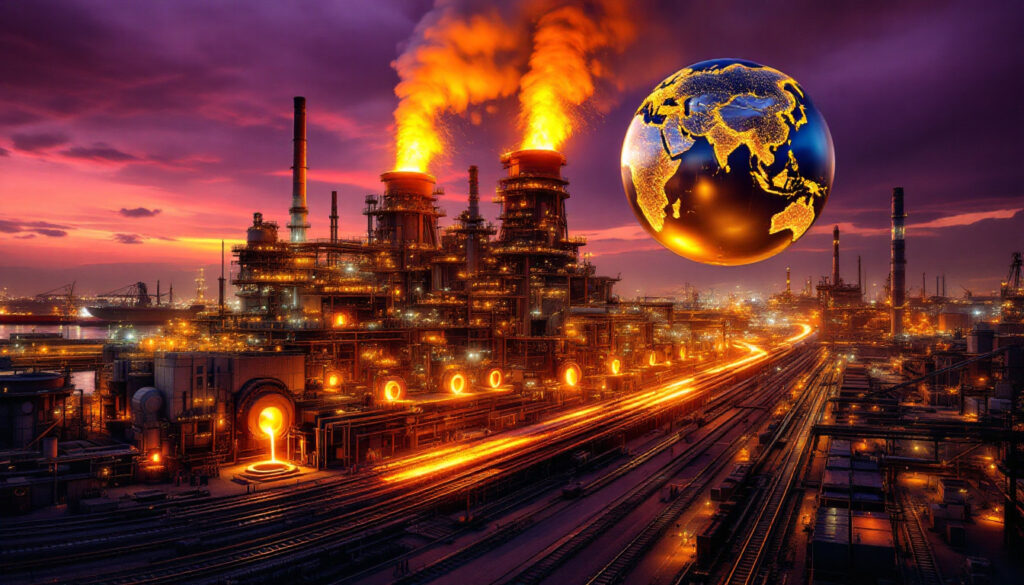Global Crude Steel Outlook for 2025: Market Trends and Production Forecast
Global steel markets are poised for a significant shift in 2025, with Fastmarkets' latest analysis projecting a bearish turn that contradicts previous expectations. The revised outlook signals challenges ahead for steelmakers worldwide, driven by complex macroeconomic factors and China's Iron Ore Imports trends that continue to influence the industry.
Current Production Forecast and Market Overview
The global crude steel production forecast for 2025 has been revised downward to 1.846 billion tonnes, representing a substantial 34 million tonne (Mt) reduction from earlier estimates. This adjustment marks a dramatic reversal from previous projections, with 2025 now expected to see a year-on-year decline of 32Mt compared to 2024 levels, rather than the 23Mt gain that was initially anticipated.
The downward revision comes despite Q4 2024 production exceeding expectations by nearly 21Mt, with global output reaching 1.878 billion tonnes. This unexpected surge was primarily driven by production increases in China, the United States, and other Asian markets (excluding China), creating a higher baseline that makes the projected decline even more significant.
Industry analysts at Fastmarkets have noted that steel prices hit bottom in July 2024, with only a modest, meandering recovery through the second half of the year. This tepid price performance signaled underlying structural weaknesses that are now manifesting in production forecasts.
"What we're seeing is a fundamental disconnect between production capacity and actual market demand," explains Kim Leppold, Chief Steel Analyst at Fastmarkets. "The strong finish to 2024 masked deeper issues that are now becoming impossible to ignore, particularly in construction-dependent markets."
What Factors Are Driving the Bearish Outlook?
Multiple interconnected factors are contributing to the pessimistic production forecast for 2025, creating a perfect storm for steel markets globally.
Trade policy uncertainty has emerged as a critical destabilizing force. The expansion of Section 232 tariffs under Trump's Policy Impact on Commodities has created significant market disruptions, with reciprocal tariffs from trading partners further complicating the landscape. Steel markets, which traditionally require long-term planning horizons, are particularly vulnerable to such policy volatility.
Weakening global steel demand amid economic uncertainties represents another major challenge. Consumer confidence has faltered in key markets, while industrial production metrics have shown concerning declines across both developed and emerging economies. The manufacturing sector's slower-than-expected recovery has dampened steel consumption.
Environmental regulations have increasingly impacted production capabilities, particularly in China and Europe. Carbon emission targets have forced steelmakers to reduce output or invest heavily in cleaner technologies, creating transitional production constraints that affect global supply.
Ongoing geopolitical conflicts continue to disrupt supply chains for both raw materials and finished steel products. The Russia-Ukraine conflict, tensions in the Middle East, and strategic competition between China and Western economies have created persistent logistics challenges and iron ore volatility insights that affect key inputs like coking coal and iron ore.
Perhaps most significantly, a construction slowdown in key markets has undermined steel demand fundamentals. China's property sector crisis has deepened, with residential construction starts down over 20% from peak levels. Similar, though less severe, construction market weaknesses have emerged in Europe and parts of North America.
Regional Production Trends and Forecasts
China's Production Outlook
China's steel production is expected to fall below the symbolic threshold of 1 billion tonnes in 2025, marking a significant milestone in the country's industrial trajectory. According to Fastmarkets' analysis, China will struggle to reach this production level in the longer term as well, signaling a structural shift rather than a cyclical downturn.
The primary driver behind China's production decline is the ongoing stagnation in its construction sector. Residential property investment has contracted for three consecutive years, with the government's attempts to stabilize the market yielding limited results. Commercial construction has failed to compensate for this decline, creating a significant demand gap in a sector that has historically consumed over 60% of China's steel output.
Export opportunities that might otherwise absorb excess production capacity have been increasingly constrained by trade actions. The EU, US, and several emerging economies have implemented or expanded anti-dumping measures against Chinese steel products, limiting the country's ability to redirect domestic oversupply to international markets.
The Chinese government itself has recommended lower steel production levels as part of both economic rebalancing efforts and environmental initiatives. The Ministry of Industry and Information Technology has set production caps for key steelmaking provinces, with particular focus on reducing output in areas with high pollution levels.
"China's era of expanding steel production may be permanently over," notes Fastmarkets' Beijing correspondent. "The combination of demand weakness, trade barriers, and government policy creates a new ceiling that's likely below the symbolic billion-tonne mark."
India's Growth Trajectory
India's steel production forecast has been downgraded despite its positive long-term outlook. While the country remains the brightest spot in global commodity market insights, its near-term growth has been constrained by several factors.
Public infrastructure investment has underperformed expectations despite ambitious government targets. Project delays, funding constraints, and administrative hurdles have slowed the pace of steel-intensive infrastructure development, particularly in transportation and urban development sectors.
The country has increased its reliance on competitive export markets as domestic consumption growth moderates. Indian steelmakers have expanded their presence in Southeast Asia, the Middle East, and parts of Africa, but face intense price competition and margin pressure in these markets.
Despite these challenges, India continues to show modest growth, with production expected to increase by approximately 3.5% in 2025 – a positive figure, but below the 6-7% growth rates projected in earlier forecasts. The implementation of the National Steel Policy remains a key long-term driver, with its target of 300Mt capacity by 2030 still considered achievable, if delayed.
North American Production Challenges
The North American steel landscape faces significant headwinds, with the US forecast revised to a 1.5Mt year-on-year decline, compared to the previous projection of a 9Mt boost. This dramatic shift reflects changing market dynamics under the current administration's trade policies.
Mexico is struggling to reach its 14Mt production target amid regional economic uncertainties and competitive pressures. The country's steelmakers face particular challenges from the closure of Altos Hornos de México S.A. (AHMSA) works, which has disrupted domestic supply chains and created market imbalances.
Vacillating tariff policies have profoundly affected manufacturer sentiment across the region. While Section 232 tariffs initially boosted domestic producer confidence, their expansion and the resulting retaliatory measures have created complex supply chain challenges that undermine the benefits for many steel consumers.
The steel industry is also contending with limited demand growth in the US macroeconomic environment. Housing starts remain below historical averages, automotive production has plateaued, and infrastructure spending has delivered slower-than-expected steel consumption growth. These factors collectively contribute to North America's disappointing production outlook.
Impact of Trade Policies on Global Steel Production
US Tariff Effects
The Section 232 tariffs and new reciprocal tariffs implemented under the current administration have created significant market uncertainty globally. Originally intended to protect domestic steel production, these measures have had complex and often counterproductive effects on the broader market.
The tariffs have generated inflationary pressure from import restrictions, with downstream manufacturers reporting steel price increases of 15-25% following implementation. These higher input costs have reduced competitiveness for steel-consuming industries like automotive, appliance manufacturing, and construction.
Initial capacity utilization improvements following tariff implementations proved short-lived. US steel mills saw utilization rates temporarily exceed 80% in early 2024, but these gains weren't sustained as market adjustments and slowing demand eroded the protective benefits of the tariffs.
Waning market sentiment has increasingly affected steel product demand across multiple sectors. Purchasing managers report greater caution in inventory management and project planning due to price volatility and supply uncertainties created by the shifting trade landscape.
"The tariff regime has fundamentally altered supply chain planning," explains a senior procurement executive at a major US manufacturer. "We're seeing more localized sourcing but at higher costs, creating competitive disadvantages in global markets for finished goods."
Southeast Asian Market Dynamics
Steel producers in Southeast Asia are facing significant headwinds from anti-dumping duties imposed by multiple trading partners. These measures have restricted export opportunities for regional producers at a time when domestic consumption growth has moderated.
The competitive landscape has intensified as markets adjust to China's reduced export presence. Vietnamese, Indonesian, and Malaysian producers have attempted to fill the gap left by restricted Chinese exports in certain markets, but face fierce price competition and narrowing margins in doing so.
Trade restrictions are increasingly limiting growth potential across the region. With the EU, US, and other major markets implementing protective measures, Southeast Asian producers find themselves caught in complex trade disputes despite their relatively minor global market share.
Future Outlook and Market Recovery
Long-Term Production Forecast
Positive growth is expected to return to global steel markets in 2026, according to Fastmarkets' long-term projections. The anticipated recovery will likely be gradual rather than dramatic, with production increases of 2-3% annually through 2028 as market fundamentals stabilize.
Significant downside risks remain, however, particularly related to trade policies and economic growth trajectories. The potential for retaliatory tariffs and trade war escalation represents the single largest threat to recovery prospects, with each new round of protectionist measures further fragmenting global markets.
"We're entering a period of regionalization in steel markets," notes Fastmarkets' global strategist. "The integrated global market of the early 2000s is giving way to more distinct regional ecosystems with different price dynamics and supply-demand balances."
Supply Chain Implications
The shifting regional production balances are creating both challenges and opportunities for steel supply chains globally. Traditional trade flows are being disrupted, forcing both producers and consumers to develop new supplier relationships and logistics solutions.
Manufacturers are increasingly reconsidering investment decisions based on the changing steel market landscape. Projects that depend on globally competitive steel inputs face heightened uncertainty, with some firms delaying capacity expansions until the trade environment stabilizes.
The market disruptions underscore the need for improved risk management tools and price transparency. Fastmarkets reports growing interest in hedging instruments and index-linked contracts as steel consumers seek to mitigate price volatility and supply uncertainty in this transitional period.
Expert Analysis and Market Indicators
Fastmarkets' March 2025 forecast represents a significant shift from its December 2024 outlook, reflecting rapidly evolving market conditions. The organization's analysts point to deteriorating fundamentals across multiple metrics, suggesting the bearish outlook is not merely a temporary correction.
Capacity utilization rates have failed to maintain expected improvements, particularly in regions like Europe and North America where utilization has fallen back below 75% after brief recoveries in late 2024. This persistent underutilization indicates structural imbalances between production capability and actual demand.
Market fundamentals continue to weaken as demand stalls across key consuming sectors. The construction industry, which accounts for approximately 50% of global steel consumption, shows particular weakness with declining investment in both residential and commercial projects across major economies.
"The market correction we're witnessing isn't cyclical but structural," concludes Fastmarkets' senior steel analyst. "The industry needs to adapt to a new normal where growth is more modest, regional dynamics more distinct, and environmental considerations increasingly central to production decisions."
FAQ: Crude Steel Market Outlook
What is causing the decline in global crude steel production for 2025?
The decline is primarily driven by trade policy uncertainty, including tariffs under the current US administration, weak construction demand in China's property sector, increasingly stringent environmental regulations in major producing regions, and ongoing geopolitical conflicts affecting global supply chains and market sentiment. These factors collectively undermine producer confidence and investment in new capacity.
How are tariffs affecting the steel industry globally?
Tariffs are creating significant market fragmentation and uncertainty, reducing export opportunities for producers in countries targeted by protective measures, causing inflationary pressure in steel-consuming industries, and affecting manufacturer sentiment and investment decisions. The Section 232 tariffs in the US and retaliatory measures from trading partners have disrupted traditional trade flows and created price disparities between regional markets.
Will China's steel production recover to previous levels?
According to Fastmarkets' analysis, China's annual output will likely remain below 1 billion tonnes throughout the longer-term forecast period. This represents a structural shift driven by stagnating construction demand, government policies favoring economic rebalancing away from heavy industry, environmental restrictions on steel production, and export constraints created by international trade barriers. The era of expanding Chinese steel production appears to have ended permanently.
When can we expect a recovery in global steel production?
The forecast indicates positive growth may return in 2026, though at modest rates of 2-3% annually. Significant downside risks remain, particularly if retaliatory tariffs and trade tensions escalate further. The recovery will likely be uneven across regions, with India and Southeast Asia potentially rebounding more quickly than mature markets like Europe and North America. Long-term steel demand fundamentals remain positive, but the industry faces a period of adjustment to new regional market realities and environmental constraints that will shape mining industry predictions 2025 and beyond.
Looking to Profit from Major Mineral Discoveries?
Gain a significant market edge with Discovery Alert's proprietary Discovery IQ model, delivering real-time notifications on ASX mineral discoveries that could generate substantial returns. Explore how historic discoveries have created exceptional investment opportunities by visiting the Discovery Alert discoveries page and begin your 30-day free trial today.




